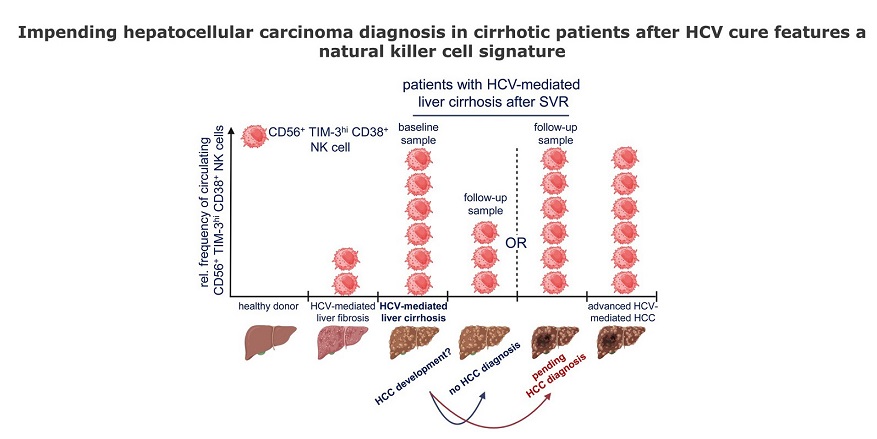Cancer News: TIM-3 And CD38 Proteins Identified As Potential Tumor Markers For Hepatocellular Carcinoma
Nikhil Prasad Fact checked by:Thailand Medical News Team Mar 11, 2024 1 year, 9 months, 1 week, 4 days, 3 hours, 35 minutes ago
Cancer News: The landscape of cancer research continually evolves, and recent advancements have illuminated potential avenues for early detection and intervention in hepatocellular carcinoma (HCC). Among the myriad challenges in oncology, HCC stands out as a formidable foe, particularly in individuals afflicted with chronic hepatitis C (HCV). Despite the advent of direct-acting antivirals (DAAs) that effectively eradicate HCV, the specter of HCC looms large, especially in patients with underlying liver cirrhosis. In this
Cancer News report, the pioneering work of researchers at Hannover Medical School in Germany offers a glimpse into the intricate interplay between the immune system and tumorigenesis, paving the way for innovative strategies to identify high-risk individuals and forestall the onset of HCC.
 Proteins TIM-3 And CD38 Identified As Potential Tumor Markers For Hepatocellular Carcinoma
Understanding the Role of NK Cells in Immune Surveillance
Proteins TIM-3 And CD38 Identified As Potential Tumor Markers For Hepatocellular Carcinoma
Understanding the Role of NK Cells in Immune Surveillance
Central to the body's defense against infections and malignancies are natural killer (NK) cells, a vital component of the innate immune system. Tasked with identifying and eliminating aberrant cells, including virus-infected and tumor cells, NK cells serve as the vanguard of immune surveillance. Within the liver, where the battle against pathogens and toxins rages incessantly, NK cells comprise a substantial proportion of the immune cell milieu, safeguarding hepatic tissue integrity. Dr Norman Woller, leading the charge at Hannover Medical School, underscores the pivotal role of NK cells, stating, "In our liver, the proportion of NK cells is between 30% and 50% of all immune cells, so they probably play a central role in maintaining the immunity of liver tissue."
Unraveling the Mysteries of NK Cell Imprinting
Unlike their adaptive counterparts, NK cells lack specificity in antigen recognition, yet they possess a remarkable ability to adapt and respond to cues from their microenvironment. One such phenomenon elucidated by researchers is the concept of "NK cell imprinting," whereby encounters with tumor cells leave a lasting mark on NK cell function and phenotype. Dr. Woller elucidates this intricate interplay, remarking, "The cancer cells leave an imprint on the NK cells, so to speak." This insight forms the crux of the research endeavor, as investigators seek to decipher how these imprints influence NK cell behavior and, ultimately, the trajectory of HCC development in individuals with chronic hepatitis C.
Methodological Insights and Key Findings
Armed with a wealth of clinical specimens and cutting-edge technology, the research team embarked on a journey to unravel the enigma of HCC development in the aftermath of HCV eradication. Leveraging a comprehensive array of biomarkers and sophisticated cell sorting techniques, the investigators scrutinized NK cell profiles across various cohorts spanning the continuum of HCC progression. Among the panoply of markers examined, two proteins - TIM-3 and CD38 - emerged as frontrunners in heralding the transition from liv
er cirrhosis to HCC. Notably, these proteins exhibited conspicuous expression patterns on NK cells from patients destined to develop HCC, offering a tantalizing glimpse into the molecular underpinnings of hepatocarcinogenesis.
TIM-3 and CD38 as Harbingers of HCC
TIM-3, a pivotal regulator of immune responses, and CD38, a modulator of cell activity, emerged as linchpins in the quest for predictive biomarkers of HCC development. Dr Woller elucidates the significance of these findings, stating, "These two proteins are clearly linked to the later development of liver cancer and could therefore be used as possible tumor markers to help assess the risk of HCC development in patients with liver cirrhosis after HCV cure in good time." Indeed, the persistent co-expression of TIM-3 and CD38 on NK cells heralds a molecular signature indicative of heightened tumorigenic potential, offering a beacon of hope for early intervention and personalized risk assessment in at-risk individuals.
Functional Insights and Tissue Distribution
Beyond mere biomarker discovery, the research endeavor unearthed profound functional insights into NK cell cytotoxicity and tissue tropism. Functional assays unveiled the potent cytotoxic capabilities of NK cells bearing the TIM-3/CD38 signature, underscoring their role in immune surveillance and tumor eradication. Moreover, single-cell sequencing unveiled the spatial distribution of these NK cells, with enriched frequencies observed in liver tissue and the invasive margin, underscoring their pivotal role in the battleground against HCC.
Conclusion
In the crucible of scientific inquiry, the research conducted at Hannover Medical School represents a beacon of hope in the fight against HCC. By unraveling the intricate interplay between NK cells and HCC development in chronic hepatitis C patients, the investigators have unlocked a treasure trove of insights into early detection and personalized risk assessment. The identification of TIM-3 and CD38 as putative biomarkers heralds a new dawn in oncology, offering clinicians a powerful tool to identify high-risk individuals and tailor interventions accordingly.
The study findings were published in the peer reviewed journal: Hepatology.
https://journals.lww.com/hep/abstract/9900/impending_hepatocellular_carcinoma_diagnosis_in.761.aspx
For the latest
Cancer News, keep on logging to Thailand Medical News.
